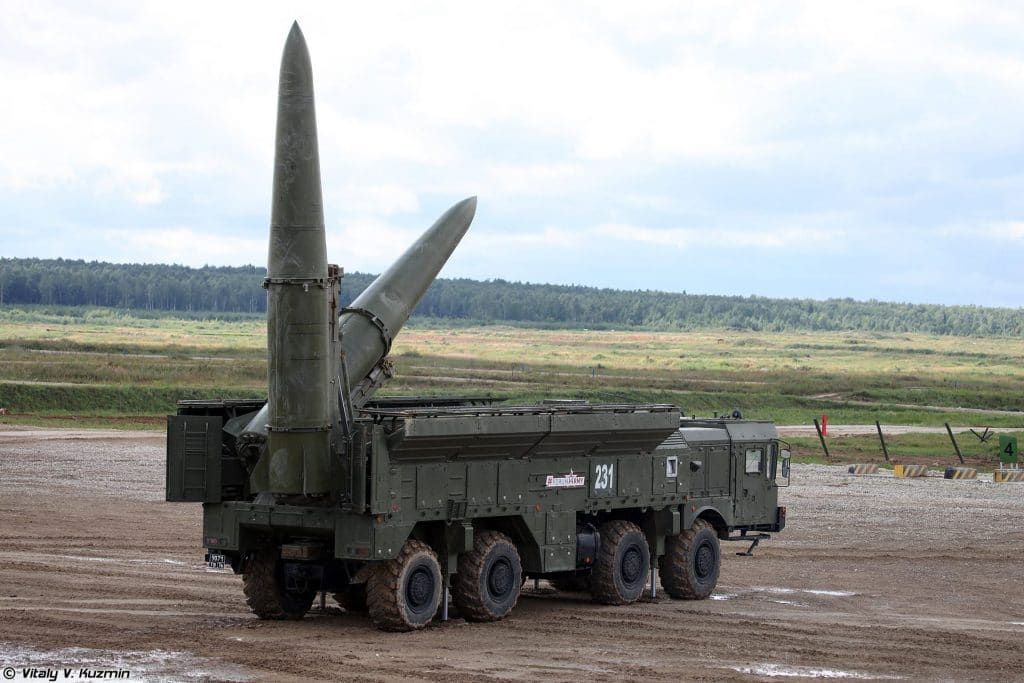Karaganov’s case for Russian nuclear preemption: responsible strategizing or dangerous delusion?
By Stephen J. Cimbala, Lawrence J. Korb | August 21, 2023
 Iskander-M short-range ballistic missile system with two 9M723K5 missiles, at a Russian demonstration of military technology in 2017. The Iskander system is reported to be capable of firing ballistic missiles that can carry a tactical nuclear warhead. Photo by Vitaly Kuzmin
Iskander-M short-range ballistic missile system with two 9M723K5 missiles, at a Russian demonstration of military technology in 2017. The Iskander system is reported to be capable of firing ballistic missiles that can carry a tactical nuclear warhead. Photo by Vitaly Kuzmin
In a controversial essay, noted Russian academician, commentator, and former Kremlin advisor, Sergei Karaganov recently called for Russia to launch limited nuclear strikes on Western Europe as a way to restore nuclear deterrence and bring the war in Ukraine to a favorable conclusion. Even though the idea—that concepts applicable to nuclear coercion prior to nuclear first use can be extended into the domain of actual nuclear war fighting—is not entirely new,[1] not surprisingly Karaganov’s article provoked a vigorous debate in Russia and the West. This proposal and other Russian political and military thinking about nuclear weapons raise profound questions about whether Russia might attempt to conduct a so-called limited nuclear war.
During its invasion of Ukraine, Russia has clearly engaged in a cross-domain campaign of coercion that includes non-nuclear, informational, and nuclear elements. Given the distinct possibility of uncontrollable escalation, it seems unlikely that Moscow would follow Karaganov’s logic and use tactical nuclear weapons in an attempt to end the conflict in Ukraine on Russian terms. But unlikely does not mean impossible, and even if Karaganov’s ideas are only part of Russia’s disinformation efforts, their publication illustrates a need for Moscow, Washington, and Brussels to plan more actively for a de-escalation of hostilities that does not include nuclear weapons.
Karaganov’s call for nuclear preemption. Karaganov is a prominent political scientist and foreign policy expert who has advised both Boris Yeltsin and Vladimir Putin. In a controversial essay published in June, he argued that Russian nuclear preemption was needed to reawaken NATO fears of nuclear attack and reestablish deterrence, to prevent an otherwise inevitable escalation of the war in Ukraine to global thermonuclear war. According to Karaganov: “We will have to make nuclear deterrence a convincing argument again by lowering the threshold for the use of nuclear weapons set unacceptably high, and by rapidly but prudently moving up the deterrence-escalation ladder… The enemy must know that we are ready to deliver a preemptive strike in retaliation for all of its current and past acts of aggression in order to prevent a slide into global thermonuclear war.”[2]
Numerous rejoinders to Karaganov’s article appeared promptly, including some written by Russian nuclear policy experts.[3] Two aspects of this Russian back and forth on nuclear preemption are especially important. First, Karaganov at least implicitly draws upon Western notions of nuclear escalation and control that were controversial on both sides of the Iron Curtain during the Cold War and remain so now.[4] Second, it is possible that Karaganov is engaged in disinformation prompted by Russian government sources that would prefer this messaging to come from a purportedly objective academic source instead of the Kremlin. On the other hand, official Russian state policy does not necessarily support Karaganov’s position on the advisability of nuclear preemption.[5]
The mutiny of June 2023. The June 2 rebellion by the Wagner group of mercenary forces headed by Yevgeny Prigozhin compounds the debate among nuclear policy specialists about the use of nuclear weapons in Ukraine or elsewhere in Europe. Although the Prigozhin uprising was short lived and aborted by a bizarre endgame involving the president of Belarus, it raised questions about the degree to which the armed forces of Russia were on the same page with respect to Putin’s war policy and commitment to the regime altogether.[6] As Mikhail Komin of the Carnegie Endowment for International Peace has noted: “The Russian armed forces are not monolithic, but consist of a multitude of rival groups competing for positions and sources of income. Far from everyone within the military leadership is loyal to (Defense Minister Sergei) Shoigu and General Staff Chief Valery Gerasimov personally: as a rule, that’s only those who have been promoted through the ranks with their help, or who have been awarded lucrative Defense Ministry-linked contracts. In recent months, Prigozhin has been trying to win over another group of generals: those whose careers took off under the reformist perspective predecessors of Shoigu and Gerasimov—Anatoly Serdyukov and Nikolai Makarov—and stalled after their departure.”[7]
The existence of division as among the military leadership of Russia and the possibility of presidential vacillation with respect to who is who in the chain of command are sufficiently disturbing developments without factoring nuclear weapons into the equation. But Russia has the world’s largest nuclear arsenal, taking into account all nuclear weapons, strategic and non-strategic and deployed and non-deployed. If command authority for nuclear action or the weapons themselves were to fall into the hands of disputing praetorians and/or politicians, a dangerous situation would exist—and not only for Russia. Currently, it is assumed that the codes for nuclear release in Russia reside with the president, the minister of defense, and the chief of the general staff. The final decision for nuclear first use would rest with President Putin. But all these assumptions rest on the existence of a stable political environment of relationships among the various military and security services of Russia and their enduring subservience to civilian authority.[8]
Escalation. Debates about nuclear first use or escalation involve two kinds of prospective acts: so-called tactical or non-strategic nuclear weapons made available for battlefield use, and second, limited strikes with strategic nuclear weapons that purposely aim at high value military and/or command and control assets but spare cities and other value targets. In theory, both these courses aim to coerce an adversary to agree to back down short of a massive nuclear war, but critics scoff at the idea of “limited” nuclear wars as a chimera.
Even so, beginning with the Kennedy administration, every US president has sought to escape from a single-variant nuclear war plan and to have available a variety of limited nuclear options for theater or strategic nuclear war.[9] During the Cold War years, NATO fielded a variety of non-strategic nuclear weapons in Western Europe, on the assumption that NATO conventional forces were collectively inferior to those of the Soviet Union and its Warsaw Pact allies. The situation now is the reverse: NATO holds the commanding heights of advanced-technology conventional warfare, so Russia maintains many more deployed non-strategic nuclear weapons than NATO (the latter having only about 100 air delivered weapons deployed in Belgium, Germany, Italy, the Netherlands, and Turkey).
The question remains whether a nuclear first use of a non-strategic or tactical nuclear weapon would automatically expand into a much wider and more destructive conflict or could be contained below the threshold of general nuclear war. A further question: Once one side or the other has launched an attack using strategic nuclear weapons against selective military targets but sparing cities, could reciprocal restraint in counterforce targeting be maintained, short of all-out attacks against population centers?
Answering either question requires some conjecture about US versus Russian approaches to escalation control and management. It seems straightforward to set tactical nuclear weapons apart from longer-range and higher-yield strategic nuclear forces; a “firebreak” between the two kinds of weapons can therefore be imagined. But in the confusion and alarm surrounding the start of nuclear warfare, mutual agreement on thresholds for limiting escalation may be difficult to arrange. Even more challenging would be the establishment of thresholds and firebreaks with respect to strategic nuclear exchanges. The rationale for limited strategic options includes two aspects: the immediate destruction that the weapons cause, and, the message that they send about the ability and willingness to up the ante of destruction unless the other side agrees to terms. From the US standpoint, the objective is to influence the opponent with the “manipulation of risk” and the “threat that leaves something to chance” as explained by Thomas C. Schelling in his seminal work Arms and Influence.[10]
Whether this approach of messaging with (limited) mass destruction is acceptable to Russians at this time is arguable, but decisions on how to respond would probably be very circumstantial and scenario dependent. Since the beginning of Russia’s war against Ukraine in 2022, Vladimir Putin has made explicit references to the possibility of nuclear first use in case of unacceptable losses by Russia. What remains to be determined is when, or if, that threshold of political or military unacceptability has been reached.
Nuclear weapons can be “used” without having actually been fired. They are instruments for political intimidation and coercion. Russian military thinking recognizes the potential utility of nuclear weapons in this regard. As the Foreign Policy Research Institute’s Stephen Blank has noted, Russia’s nuclear threats during its war against Ukraine are part of a larger matrix that Dmitri Adamsky has termed cross-domain coercion.[11] According to Adamsky, “The current Russian cross-domain coercion campaign is an integrated whole of non-nuclear, informational, and nuclear types of deterrence and compellence. Finally, the campaign contains a holistic informational (cyber) operation, waged simultaneously on the digital-technological and on the cognitive-psychological fronts, which skillfully merges military and non-military capabilities across nuclear, conventional, and sub-conventional domains.”[12]
It follows that cross-domain coercion can apply to political and military activities prior to war, in the initial period of war, and during the stage of escalation management and-or escalation dominance. With respect to strategic deterrence, this perspective was articulated in Russia’s National Security Strategy of December 2015, which stated that interrelated “political, military, military-technical, diplomatic, economic, informational, and other measures” are being developed and implemented “in order to ensure strategic deterrence and the prevention of armed conflicts.”[13] If deterrence fails, Russia has not ruled out the possibility of a limited first use of nuclear weapons to deter expansion of the war by the opponent.
Since the Russian invasion of Ukraine, there has been considerable US discussion of the prospect that Russia might “escalate to de-escalate” a conventional war by means of nuclear first use, but this prospect must be put into a broader context. As Blank has explained: “But while nuclear use in a first-strike mode to retrieve a losing conventional war and force NATO to de-escalate may be part of the strategy (escalate to de-escalate), that arguably is merely a part of a much broader nuclear strategy that relies heavily on the psychological and intimidating or informational components of nuclear weapons. In other words, we see a broader nuclear strategy that aims to use these weapons to control the entire process of escalation throughout the crisis from start to finish. If the crisis becomes kinetic, escalating to de-escalate may well become an operative possibility.”[14]
With regard to Russia’s war against Ukraine (and to war generally), the political objectives that states fight for are related to their willingness to escalate or de-escalate the intensity of fighting and the attendant costs of doing so. For Russia, its war against Ukraine has been conceived by its leadership as existential, instead of merely opportunistic. Putin has repeatedly claimed that the war in Ukraine is about the survival of a uniquely Russian civilization and culture that must either extend its influence abroad or wither on the vine. From this perspective, a Russia without de facto or de jure control over Ukraine is no longer an empire, and a Russia that is not an empire is not the great power that its history has mandated as Russia’s destiny. Along with this theorizing, in 2022 the term “Anglosaksy” (Anglo-Saxons) has appeared frequently in recent Kremlin usage as a derogatory reference to duplicitous Americans and their European allies. It predates the Putin regime; in the latter 1940s and early 1950s it was a reference to the Soviet Union’s most important enemies who were assumed to be plotting the destruction of the regime in Moscow.[15]
If ambitious political objectives in Moscow are combined with a military-strategic net assessment that a prolonged war of attrition in Ukraine favors Russia against its opponents, the likelihood going forward is a tit-for-tat expansion of conventional war fighting with a background of nuclear coercion du jour.[16] Crossing the threshold of nuclear first use under these circumstances is not impossible, but neither is it inevitable.
The nuclear outlook in Ukraine. The assumption that Russian nuclear first use can take place in Ukraine or elsewhere in Europe without provoking further nuclear attacks assumes a large amount of political and military restraint on the part of the United States and NATO. At a minimum, a meaningful and highly destructive NATO military response with conventional weapons against Russian forces in Ukraine and possibly in Russia would be expected. Russia would then be in a position of stalemate unless it responded with further nuclear strikes against NATO military targets with increased collateral damage to civilians, compared to its nuclear first use. In response to this attack, NATO would almost certainly resort to nuclear retaliation of some kind, including against targets in Russia.
The forgoing scenario is admittedly speculative. Regardless of the specifics, the arguments for assuming that states can fight a controlled and limited nuclear war lack political and military plausibility. Perhaps future AI systems—disembodied from human “frailties,” including ethical inhibitions and training in military history—might do so. Real heads of state and warlords would find it harder. History (and Clausewitz) suggest that the essential nature of war is for fighting to escalate unless the brakes are applied by determined political leaders and their military advisors.[17] History also suggests that bureaucracies can only do what they have rehearsed and practiced in advance. The need for planning and thinking about de-escalation in Ukraine is now more urgent than ever in Moscow, Washington, and Brussels, and far more reasonable than Sergei Karaganov’s delusory musings about walking on the wild side of nuclear first use.
Notes
[1] For example, Australian expert Desmond Ball has contended: “It does not follow that all limited or selective nuclear operations would necessarily lead to an all out nuclear exchange. Small, carefully conducted attacks designed to demonstrate political resolve could well have a salutary effect. However, it is difficult to envisage the maintenance of control in situations beyond the detonation of several tens of nuclear weapons.” See “Can Nuclear War Be Controlled?” at: https://www.tandfonline.com/doi/abs/10.1080/05679328108457385?journalCode=tadl19.
[2] See “A Difficult but Necessary Decision” at: https://eng.globalaffairs.ru/articles/a-difficult-but-necessary-decision/. Karaganov reiterates the same arguments in “Here’s why Russia has to consider launching a nuclear strike on Western Europe”: https://www.rt.com/russia/578814-russia-has-to-consider-launching-nuclear-strike/
[3] See, for example: Dmitri Trenin, “The Ukrainian conflict and nuclear weapons,” Russia in Global Affairs, June 20, 2023, in Johnson’s Russia List 2023 – #18 – June 20, 2023, [email protected]; and Ivan N. Timofeev, “A Preemptive Nuclear Strike? No!,” Russia in Global Affairs, June 20, 2023, https://eng.globalaffairs.ru/articles/a-preemptive-nuclear-strike-no/
[4] For example: Herman Kahn, On Thermonuclear War (Princeton, N.J.: Princeton University Press, 1960); and Kahn, On Escalation: Metaphors and Scenarios (London: Routledge Publishers, 2009 edition).
[5] See Ministry of Foreign Affairs of Russia, “Basic Principles of State Policy of the Russian Federation on Nuclear Deterrence”: https://hansdevreij.com/2022/03/06/basic-principles-of-state-policy-of-the-russian-federation-on-nuclear-deterrence/
[6] See “Short-Lived Mutiny in Russia Sheds Light on Putin’s Hold on Power” at: https://www.nytimes.com/2023/06/24/us/politics/us-russia-putin.html; “Yesterday’s Putin Is Gone” at: https://www.nytimes.com/2023/06/27/opinion/putin-russia-coup.html; “Putin: Disastrous but indispensable for the system he created?” at: https://responsiblestatecraft.org/2023/06/25/putin-disastrous-but-indispensable-for-the-system-he-created/; and “What Happens to Putin Now?” at: https://www.nytimes.com/2023/06/27/opinion/putin-russia-ukraine.html
[7] See “Who Was Prigozhin Counting On to Back His Failed Mutiny?” at: https://carnegieendowment.org/politika/90051
[8] Insurgents who took possession of a nuclear weapons storage facility would not necessarily be able to arm those warheads or mate them with their assigned delivery systems in good time. For details, see: https://thebulletin.org/2023/06/what-would-happen-if-a-military-group-took-over-russias-nuclear-arsenal/
[9] Fred Kaplan, The Bomb: Presidents, Generals, and the Secret History of Nuclear War (New York: Simon and Schuster, 2020).
[10] Thomas C. Schelling, Arms and Influence (New Haven, Ct: Yale University Press, 1967).
[11] Dmitri Adamsky, Cross-Domain Coercion: The Current Russian Art of Strategy, Proliferation Paper 54 (Paris: Institut francais des relations internationals, 2015), cited in Stephen Blank, “Nuclear Weapons in Russia’s War Against Ukraine,” Naval War College Review, v. 75, no. 4 (Autumn 2022), pp. 53-78, citation p. 58.
[12] Adamsky, Cross-Domain Coercion, pp. 1-2, cited in Blank, “Nuclear Weapons in Russia’s War Against Ukraine,” p. 58.
[13] On the Russian Federation’s National Security Strategy, President of Russia’s Website, December 31, 2015, cited in Timothy L. Thomas, Russia: Military Strategy – Impacting 21st Century Reform and Geopolitics (Ft. Leavenworth, Kansas: Foreign Military Studies Office, 2015), p. 112.
[14] Blank, “Nuclear Weapons in Russia’s War Against Ukraine,” p. 61
[15] Andrei Kolesnikov, “The Plot Against Russia: How Putin Revived Stalinist Anti-Americanism to Justify a Botched War,” Foreign Affairs, May 25, 2023, in Johnson’s Russia List 2023 – #102 – May 26, 2023, [email protected]
[16] Despite some assessments that the Russian armed forces have underperformed in Ukraine relative to expectations, from a historical perspective Russian military thinking has evolved quite substantially. See: Capt. Randy Noorman, “The Russian Way of War in Ukraine: A Military Approach Nine Decades in the Making,” Modern War Institute, June 15, 2023, https://mwi.usma.edu/the-russian-way-of-war-in-ukraine-a-military-approach-nine-decades-in-the-making/
[17] Carl von Clausewitz, On War, edited and translated by Michael Howard and Peter Paret (Princeton: Princeton University Press, 1976), pp. 87-89 and passim.
Together, we make the world safer.
The Bulletin elevates expert voices above the noise. But as an independent nonprofit organization, our operations depend on the support of readers like you. Help us continue to deliver quality journalism that holds leaders accountable. Your support of our work at any level is important. In return, we promise our coverage will be understandable, influential, vigilant, solution-oriented, and fair-minded. Together we can make a difference.
Keywords: Prigozhin, Russia, Ukraine, Wagner Group, nuclear preemption, tactical nuclear weapons
Topics: Nuclear Risk, Nuclear Weapons
















